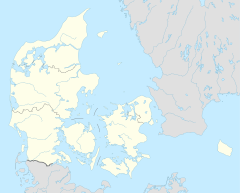Esbjerg station
|
Esbjerg station
|
|
|---|---|
| Terminal station | |

Front facade of Esbjerg station
|
|
| Location | Jernbanegade 35 DK-6700 Esbjerg Denmark |
| Coordinates | 55°28′04″N 08°27′33″E / 55.46778°N 8.45917°ECoordinates: 55°28′04″N 08°27′33″E / 55.46778°N 8.45917°E |
| Owned by | DSB and Banedanmark |
| Operated by | DSB and Arriva |
| Line(s) |
Lunderskov-Esbjerg Line Esbjerg-Struer Line |
| Platforms | 2 |
| Tracks | 4 |
| Construction | |
| Architect | Heinrich Wenck (1904) |
| History | |
| Opened | 1874 |
| Rebuilt | 1904 |
| Location | |
Esbjerg Station (Danish: Esbjerg Banegård) is the main railway station in the city of Esbjerg in southwest Jutland, Denmark.
It is the terminal station on the Lunderskov-Esbjerg Line and the Esbjerg-Struer Line. The train services from the station are operated by DSB and Arriva, and the station serves destinations including Copenhagen, Aarhus and Ribe.
The station was opened in 1874, and the present building, designed by Heinrich Wenck, was completed in 1904. With its three-storey towers flanking the central gable, it reflects a mixture of Historicist styles, some inspired by Dutch Renaissance architecture.
The first railway station in Esbjerg was inaugurated in October 1874 on Exnersgade. It was the terminus of the West Jutland line (Jyske Vestbane) from Struer to Esbjerg and of the South Jutland line (Jyske Sydbane) from Lunderskov near Kolding to Esbjerg, both being built from 1872 to 1875. Opposite the first station, a number of houses were completed in the 1890s. In 1904, Wenck's new station was opened on Jernbanegade.
Wenck's two-storey red-brick building with a slate roof has two striking towers, three storeys high, on either side of the recessed entrance. Influenced by international trends, it reflects various Historicist styles. The entrance hall with its timbered finish is reminiscent of Tyrolean designs. The building is in excellent condition following recent restoration.
...
Wikipedia

